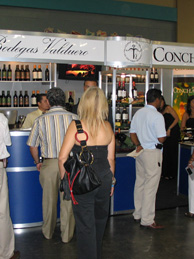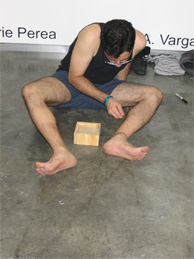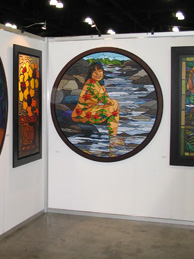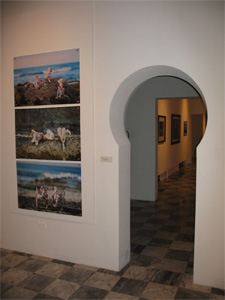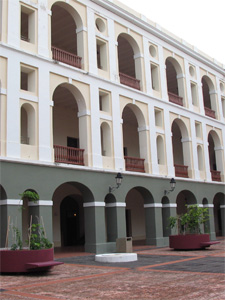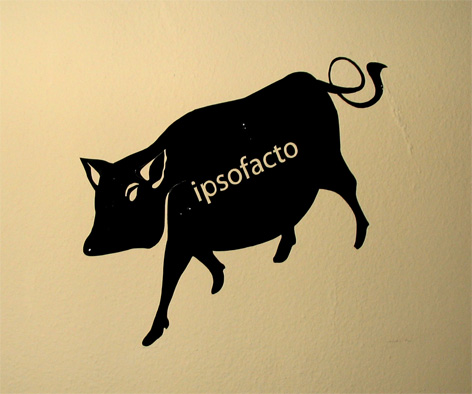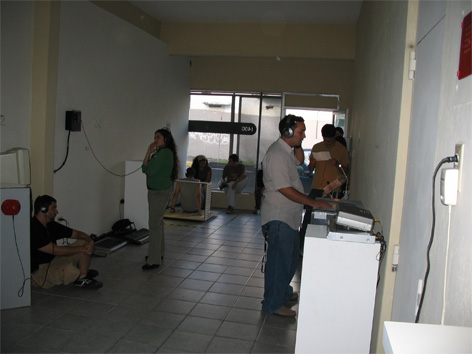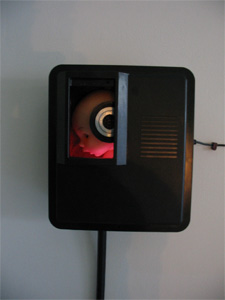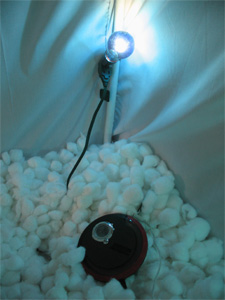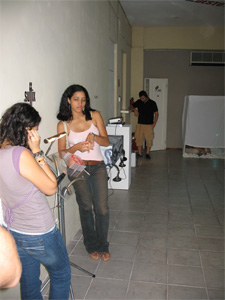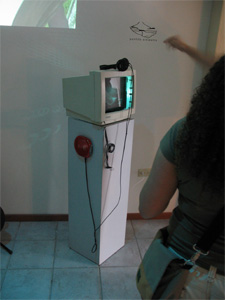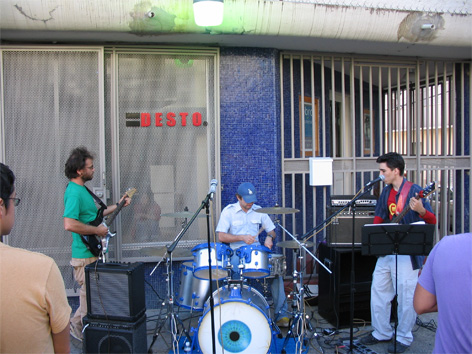|

¡Mues-tra! ¡Mues-tra! ¡Mues-tra!There is nothing quite like La Muestra Nacional de Arte in the annals of Puerto Rican art. It is, supposedly, an occasional survey of what is happening in the island art world—right now!—but has gained a reputation in the several decades of its sputtering existence for being a show without a clue: ill-formed, overstuffed, stodgy, politically susceptible, a mess. It is Puerto Rico’s own Whitney Biennial. 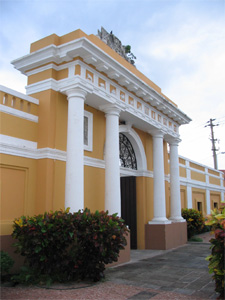
Never mind that the exhibition is one of the rare instances in which the government makes itself useful, putting its bureaucratic heft in the service of the island’s artists—La Muestra Nacional is organized by the Instituto de Cultura Puertorriqueña—the show is sneered at in some quarters for being a hidebound repository of “official” art. And it goes without saying that many folks don’t appreciate not being chosen, even though the whole process is as atavistic as the anointment of Mexican presidential candidates, in which the favored one among the beseeching multitudes ritually gets el dedo from the reigning Bozó.
La Muestra Nacional is a genuine poser, all mysterious procedures, ramshackle quarters, and hopping mad refusés, and you have to wonder why it bothers to bestir itself every two or three years. At Rotund World,
we’re much too scrupulous to venture an opinion—one of our number served in the exhibition’s high command, or running-dog clique if you prefer—but we strongly suggest that you head on over to the opening and take a look for yourself. We admit that, like any group project with the thinnest of pretexts, the show is a hopeless melange. Certain passages will leave visitors reeling with their unlikeliness. But there is a generous helping of the vanguard-like youth movement that so has the island abuzz, and outstanding work by a remarkable number of the usual suspects. One day a glossy catalogue with a rather exhaustive, but fun, essay will appear. La Puntilla and La Ballajá, the venerable sites of the show, are drafty colonial era throwbacks, it’s true, but each has charms among its obvious flaws, as the Wonderlandish doorways and colonnaded passageways amply attest.
La Muestra Nacional 2005-2006 opens Friday, October 13, at 6:30 p.m. at both sites in Viejo San Juan. The artmob will be there in force, hopefully with its sense of proportion intact, and the very groovy Proyecto Pardo will supply some art-loving beats. Questions? Call 787-721-1839 with gentle inquiries of the Intituto’s frazzled, hard-working crew. Amazing SpaceAs we’re grabbing our hats and heading out the door—off to Donato for some opening night duds—we’ll leave you with a hurried though enthusiastic report about the recently-opened show at =Desto, “8-Track Audio Project,” curated by one of the space’s three co-founders, Omar Obdulio Peña Forty.
=Desto has always been a bit of a paradox bouncing from crag to outcropping in the deeply fissured Rotund brainpan. We love it just for being there, a brash, defiant answer to the insult of institutional neglect that rotundamente characterizes Puerto Rico’s attitude toward its young artists and contemporary art in general. Yet until recently we weren’t sure that the three artist-provocateur principals quite knew what to do with themselves; not as artists, to be sure, but as provocateurs. Too often they exhibited their own work or otherwise gave the space over to fun, but inevitably twee, projects.
Beginning with last month’s experimental photography exhibition, “f/4,” smartly organized by Jason Mena, =Desto seems to be finding its voice, and with a vengeance. Peña Forty’s new show, sound installations by eight artists and artist teams, would be rollicking headline news if it was an exhibition of visual art, just for what it reveals about an inventive, precocious artistic underground in our midst. Each installation consists of a listening station, original music, and a logo. The artist-musicians used, among many other things, actual instruments, digital manipulations, samples, original voice-overs, and found snippets from sources as varied as 45s, movie soundtracks, and poetry readings. You can hear at least one near nervous breakdown and several national crises in the space of a few minutes.
Peña Forty wanted the sound to be the point and all else to flow from that, so the listening stations and logos in some way reflect what comes through the headphones. The stations range from the elegantly techo circuit boxes of !Dio—a three person combo consisting of Rafael Díaz Rivera, Luis E Pérez, and Vincent Díaz Negrón—to the loosely womb-like cottonball and cloth-wall listening booth of Lalia, otherwise known as Rebecca Dávila. There is a plywood and exposed-screw platform for those for whom mere lyrics and notes never provide enough suffering, courtesy of Fosforote—Rafael Vargas—and a simple wall-mounted wooden box slathered with an expressionistic portrait by El audio, teacher-musician Victor Rodríguez Gotay. You have to visit the bathroom to experience the show’s most baroque corner, an all-over installation of pills, scrawls, and dolls in strung-up metal boxes by Ricardo Benero, whose nom de musique is Shaved; Shaved Music, that is. Benero’s operatic aspirations reveal themselves both in the manically detailed installation and the amazingly tight six-part excursion through depression and its relatively sunnier aftermath, an album titled “Amitriptyline’s Lullabies.”
We spent a couple of hours at =Desto’s opening and learned something of the complexities involved in appreciating an exhibition of this kind. Early on the gallery was largely silent if you weren’t wearing headphones; yet the activity at each station was inwardly focused and intent. A few visitors passed through briefly, donning headphones long enough to say they’d been there, but a number of people stayed and stayed and sampled everything at length. In contrast, the evening was a noisy party with a lot of hippie-jam noodling on the provided instruments while in the street outside the band U-manos threatened to actually get down at some point, though it didn’t happen while we were there.
To our 1990s-rock-and-roll-tuned ears, the predominant sonic grooves in “8-Track Audio Project” are electronic and hip-hoppy, and they may not be to every head-banger’s taste. Our favorites are two works that extensively sample soundtracks, Benero’s harrowing, consummately poetic self-appraisal and the !Dio cut in which we thrilled all over again to the voice of Richard Nixon declaring, “I am not a crook!” The exhibition is well thought-out and nicely put-together, both in its parts and its overall execution, and one of the clearest indications yet that the fringes of the Puerto Rican art scene are going supersonic, and the culture better get its runways ready. Call us easily impressed if you will, but better still you should call the gallery and arrange a visit while “8-Track Audio Project” is still blasting. Omar is your man and 787-633-3381 is the number. The gallery is located in Santurce, Américo Salas #1400, at the corner of Hippodromo, and you might luck out and find someone there if you’re in the nabe. Images from =Desto from the top down: the logo for Ipsofacto; an installation shot from the rear of the gallery; a detail of the !Dio station on the left and Lalia on the right; an installation shot from the front of the gallery on the left, and of the station for Puntito Siniestro on the right; the band U-Manos. Return to yesteryear for Two Cards here. |

